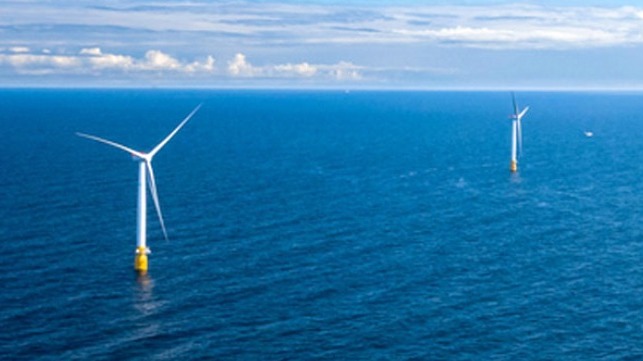DNV Forecasts Dramatic Growth in Floating Wind

DNV GL forecasts in a new report the dramatic growth of floating wind power. Projecting a dramatic fall in the cost of the new technology, they see strong opportunities in the field while also saying that more comprehensive industry standards and risk management will be required to support scaling up the technology as it is commercialized.
According to a new report from DNV, the cost of floating wind will fall approximately 70 percent by 2050 to a global average of 40 EUR per MWh. As the cost of the technology falls, they believe that new opportunities will be created as companies in the offshore wind, oil & and gas and maritime industries shift their portfolios to become less dependent on fossil fuels.
Floating wind, they forecast, will play an important role in decarbonizing the global energy system and as the technology develops. They note that following the first successful prototypes and demonstration projects, floating offshore wind is now taking the first steps in commercialization. They foresee 2000-fold growth by 2050 predicting that floating wind will grow to contribute two percent of the world’s power supply in the next 30 years.
“We know that floating wind is technically feasible,” says Remi Eriksen Group President & CEO of DNV GL. “The challenge now is to move rapidly to commercial deployments. There is a wealth of expertise to call on. The know-how from bottom fixed offshore wind, the competences of shipyards, and of oil and gas contractors all broadly align with the technical, logistical and operational challenges of floating wind.”
As part of the in-depth analysis of the global energy landscape published in its recent Energy Transition Outlook 2020, DNV GL forecasts a strong future scenario for floating wind energy. Its model predicted that the installed capacity of floating wind would grow from 100 MW today to 250 GW in 2050.
Unrestrained by ocean depth, DNV predicts that it will be an especially attractive option to bring wind power in reach of much more of the world’s population including the mega cities of Asia Pacific. Although the average cost is not expected to become less than for than bottom-fixed wind, the price difference will narrow as both fall the report says. Key to these savings will be the introduction of larger turbines, larger wind farms, significant technology developments and the creation of a highly cost-competitive supply chain.
“There is a lot of room for innovation and optimization, but also for brand new solutions,” said Magnus Ebbesen, Floating Wind Lead at DNV GL. “That brings some risk, but risks that can be managed and minimized. With an evolving technology, flexibility and forward thinking are imperative. Get it right, and floating wind presents a very attractive opportunity with healthy returns – for investors and the planet.”
DNV GL has played a central role in creating and implementing many of the rules and standards that have helped the maritime, oil & gas and offshore wind (fixed) industries operate and grow safely. The new report documents how learnings from established offshore industries will be important for floating wind. In particular, standardization and risk management will be essential to build stakeholder confidence.
Having been involved in the floating wind market since its beginnings, DNV provides its perspective on how floating wind will boost the energy transition and achieving the cost reductions. They explore the importance of standards to mitigate risks and the solutions for yards to achieve cost-effective floating wind construction.
DNV foresees a knowledge transfer from oil and gas projects to aid in the growth of floating wind, but also concludes that there will be a need for digital innovation to handle the technology’s complexity.
